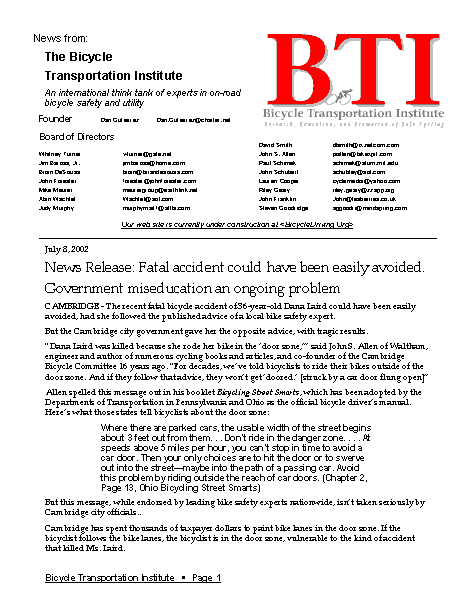
Top: Home Page
Up: Cambridge Bicycle Facilities and Program
Scroll down past the reduced image of the first page
to read the text of the press release.
Or you may download/read the
Microsoft Word '97 document

| July 8, 2002 News Release: Fatal accident could have been easily avoided. Government miseducation an ongoing problem CAMBRIDGE - The recent fatal bicycle accident of 36-year-old Dana Laird could have been easily avoided, had she followed the published advice of a local bike safety expert. But the Cambridge city government gave her the opposite advice, with tragic results. "Dana Laird was killed because she rode her bike in the 'door zone,'" said John S. Allen of Waltham, engineer and author of numerous cycling books and articles, and co-founder of the Cambridge Bicycle Committee 16 years ago. "For decades, we've told bicyclists to ride their bikes outside of the door zone. And if they follow that advice, they won't get 'doored.' [struck by a car door flung open]" Allen spelled this message out in his booklet Bicycling Street Smarts, which has been adopted by the Departments of Transportation in Pennsylvania and Ohio as the official bicycle driver's manual. Here's what those states tell bicyclists about the door zone:
But this message, while endorsed by leading bike safety experts nationwide, isn't taken seriously by Cambridge city officials.. Cambridge has spent thousands of taxpayer dollars to paint bike lanes in the door zone. If the bicyclist follows the bike lanes, the bicyclist is in the door zone, vulnerable to the kind of accident that killed Ms. Laird. Proponents of these bike lanes argue that the motorist should always look for bicyclists before opening his door. And motorists should. But the fact is that motorists don't, and then the bicyclist has no way to avoid a 'dooring' accident. "Traffic engineering works well because we avoid single-point failure modes," Allen said. "When one person makes a mistake, others see the mistake and react. That's why horns and brake pedals get such active use in Boston traffic. "But if a car door opens in your path, sometimes you can't react. That's what happened to Dana Laird. The answer to this problem isn't to expect every motorist to behave perfectly all the time. That won't work. The answer is to instruct bicyclists to avoid the door zone all the time. Had Laird heard and acted upon that advice, she would be alive today. The solution to the problem is simple but elusive: Don't ride in the door zone. This means that government agencies have to to do two things: (1) Give bicyclists proper instruction, as the Departments of Transportation in Ohio and Pennsylvania have done. (2) Don't paint bike lanes in the door zone. "A bike lane in the door zone misleads most people," added John Schubert, another bicycling author and safety expert. Schubert, who helped get Bicycling Street Smarts published as his state's bicycle driver's manual, added, "I was writing government guidelines about avoiding the door zone 24 years ago. We are supposed to know better. Door zone bike lanes are a sad example of government that won't admit its mistakes." Allen pointed out that most bicyclists need "permission" to ride outside the door zone, and a bike lane in the door zone seems to withdraw that permission. "Every vehicle operator has the right to operate his or her vehicle in a manner consistent with his or her own safety," Allen said. "And a bicyclist is a vehicle operator. A bicyclist shouldn't cringe to the right for the convenience of overtaking traffic, any more than a minivan mom should whenever a sports car appears in the minivan's rear view mirror. "For decades, we've been teaching bicyclists to ride confidently and safely, with great results. But we can't teach everyone. And our efforts to make safe cycling practices into general knowledge are thwarted when the government paints a bike lane in the most dangerous place." Years earlier, Allen had pointed out a study that found a high rate of dooring accidents in the Boston area to the Cambridge city government, together with a plea to avoid "door zone" bike lanes and a safer alternative plan. His plea was ignored. "I know all too well the desire to 'do something' for bicyclists," Allen said. "And when you paint a bike lane, it's a highly visible 'something.' That doesn't make it right. Sometimes, doing nothing is best. Sometimes, an accommodation that isn't visible, or an accommodation that most people wouldn't specifically notice, is the safest. "A bike lane in the door zone is never safe. I told Cambridge that years ago, and now I'm sorry to have to repeat the message." Schubert added that he's seen "too much creativity" from planners and designers anxious to make their mark on the world. "Traffic engineering isn't a game," Schubert said. "If you screw it up, people die." For more information:
|